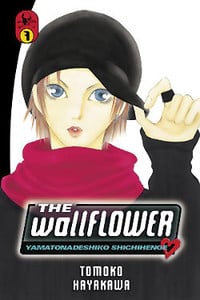Review
by Carl Kimlinger,The Wallflower
G.novel 7
| Synopsis: |  |
||
Sunako finally becomes a lady the only way possible: via hallucinogenic mushrooms. Then, when Ranmaru is mistaken for a child's father, the child exposes Sunako's unexpected nurturing side. Later a Halloween party proves that the beast inside her is still alive and well, while a visit to the hospital ends up as a close encounter with a ghost that only serves to demonstrate that Sunako is far scarier than any paranormal phenomenon. |
|||
| Review: | |||
Sometimes all it takes to save a manga from dying is a good lead character. That's the only explanation for why Wallflower continues to engage on any level. It certainly isn't the story, which is currently mired in stand-alone fluff, it isn't the other characters (unless you're a fan of Tomoko Hayakawa's bony, creepily androgynous bishounen), or even the art. No, the only reason to keep reading is Sunako. Strong, independent, principled, fiercely individualistic, stubbornly maladroit, and more than just a little psychotic, Sunako never ceases to be a joy to watch. But even Sunako is beginning to lose her edge this far into the series. She is no longer the truly terrifying force that she was in the early volumes, and her rampant psychosis has seemingly subsided. Which means no more homicide attempts, no more twisted logic, and no more Waffen SS uniforms. Sigh. The first story effectively removes Sunako by totally changing her personality, and while it's nice to see her softer side, the "illegitimate son" story doesn't really give her much of a chance to strut her stuff. The Halloween party allows her a brief return to form when the audience is treated to a demonstration of the lengths to which she'll go to secure more scary "toys" for her room, but it's back to toothless Sunako for the ghost story. Not that this volume is devoid of good Sunako moments. There's at least one per chapter: Sunako watching a gory slasher flick with unholy relish in the first chapter; Sunako playing fairy-tale witch to a child's mother ("I will raise the child.") in the second; Sunako experiencing the joys of a real-live torture chamber in the third; Sunako's twisted imaginings of what happens at a hospital in the fourth. What these moments lack, however, is the extremity and impact of Sunako's early rampages. In previous volumes, Sunako's outbursts were fueled by an outraged justice that transformed her into a very cool dervish of righteous vengeance. There is none of that here. This isn't an inherently bad thing, but when it is literally all that prevents your manga from joining the ranks of the undead, it is a serious problem. One might note the lack of any mention of the four boys in this review. There's a reason for this. There's nothing to say. The boys never had much in the way of personality (no more than is necessary to distinguish them from one another), and the story has been treading water so long that the characters are in some sort of stasis now. Hayakawa's artwork is part of the problem. She hardly even bothers to draw Sunako any more, except as a black-robed SD blob. Her backgrounds are nonexistent. She doesn't even bother with establishing settings. Occasionally the setting will change without any clue from the blank artwork, leaving it up to the reader to deduce the change from the narrative context. So where does she allocate all of her artistic energies? Well, occasionally she actually draws Sunako. These scenes, while rare, do show obvious care and are often quite beautiful, but her real focus is her bishounen. They are the most detailed characters of all (even if they spend about 50% of the time in SD form). Unfortunately their physical perfection makes it hard to tell them apart (particularly Ranmaru and Kyohei). Opinions on the boys will likely be split, but whether you find them boyaliscious or frightening, Hayakawa's obsession with pretty boys is most decidedly unhealthy; you can practically smell her hormones on the page. On the up side, her unseemly distaste for unattractive people rears its head only once over the course of this volume. All you ugly people can rest easy. Printing and binding for this volume are high-standard, with none of the fuzzy art reproduction that cropped up in some previous volumes. Del Rey's standard extras (translator's notes and an untranslated Japanese preview of the next volume) are present, as well as the author's usual drivel about concerts and bands. Sunako has always been the primary reason for reading this manga, but as it progresses, even her copious charms are beginning to wear thin. With nothing else to feed on, the manga is in real danger of shriveling up and dying. At this point, even some old fashioned shoujo angst would be welcome. Anything to stop Sunako from fading any more than she already has. |
| Grade: | |||
|
Overall : C
Story : C-
Art : C
+ Sunako is still damn cool. |
|||
| Production Info: | ||
|
Full encyclopedia details about Release information about |
||